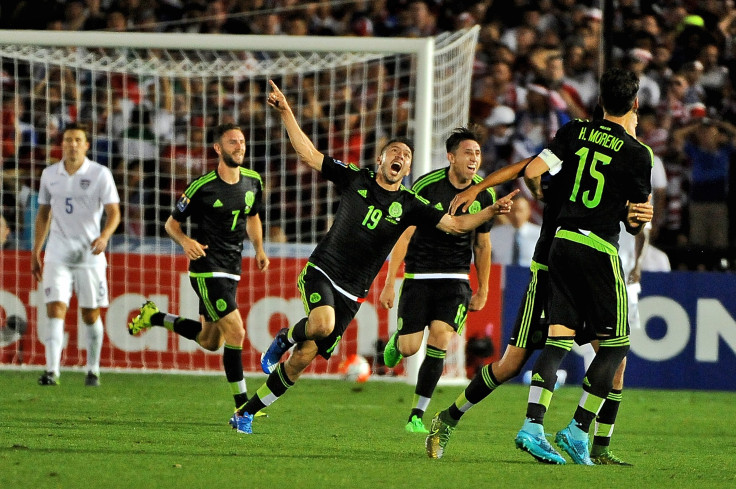USA vs. Mexico Soccer: What Lies Ahead For Both Rosters In 2016

In the three years or so following being put to the sword in the 2011 Gold Cup final, the United States enjoyed a rare period of superiority over its great rivals to the south, Mexico. As well as topping the standings in qualification for the 2014 World Cup and triumphing at the 2013 Gold Cup, the U.S. went six matches undefeated against Mexico, recording three victories -- including a first ever win at the famed Estadio Azteca. But as 2016 draws in it is Mexico that now holds the balance of power in the region.
The simplest evidence for that conclusion is of course Mexico’s 3-2 victory in the Confederations Cup playoff match at the Rose Bowl in October. While the result was only decided in extra time, the superiority of El Tri was clear. And the fact that the performance was achieved while under an interim coach and after the tumultuous end of Miguel Herrera’s reign should be all the more worrying for fans of the U.S.
For the most part, Mexico has continued to enjoy success, despite turmoil behind the scenes. The permanent appointment of Juan Carlos Osorio to replace the temporary incumbent Ricardo “Tuca” Ferretti meant Mexico moving onto their sixth coach in just over two years. In that time, the U.S. has just had one man in charge.
And it would be hard to argue that if Jurgen Klinsmann had achieved the same results as Mexico coach over the past year as he has with the U.S. that he would not have been dismissed. Klinsmann’s deal with the U.S. Soccer Federation is as solid as they come, having signed a new lucrative contract at the end of 2013 to take him through to the 2018 World Cup and giving him the additional title of technical director.
Yet even with that security there was increasing criticism directed in his direction and even the first murmurings with those in power that he could be on shaky ground. Certainly it has not been a year to remember for the U.S. men’s national team. There were friendly victories away at the Netherlands at Germany, but they count for little, especially given the failures in competitive fixtures.
A Gold Cup campaign that never got going was ended with a dismal defeat to Jamaica in the semifinals to leave the U.S. with its worst performance in the competition in 15 years. More disappointment followed in the Concacaf Cup with Mexico. And Klinsmann’s continued grasping for excuses rather than admitting his own failings has done little to help his cause.
What was most startling about the Americans’ defeat to Mexico was that after so much experimentation and searching for young players of promise since the last World Cup, in a game that truly mattered Klinsmann’s best lineup was one featuring several players unlikely to be around in Russia 2018.
There was little sight of promise either at youth levels. The Under-17 team didn’t win a game at the World Cup while the Under-23 team now faces a tough playoff against Colombia in order to make it to the Olympics. Klinsmann’s primary job in 2016, in his role as both senior team coach and U.S. Soccer’s technical director, must be to identify and develop young talent capable of replacing the likes of Clint Dempsey and Jermaine Jones while helping to produce the proactive play he is still searching for. That challenge will begin with his traditional January camp next month and continue into World Cup qualifiers before tougher tests await at the Copa America Centenario.
In contrast, the future looks bright once again for Mexico. The year ended for El Tri with an impressive 2-0 win away at Honduras, gifted by fine individual goals by young talents Jesús “Tecatito” Corona and Jürgen Damm. Corona is already impressing in Europe at Porto, while Damm could soon follow. And there are now plenty of Mexicans making their mark in the world’s biggest leagues, as well as the Champions League. Meanwhile, American players, despite Klinsmann’s urgings to do the opposite, have increasingly been heading back to Major League Soccer.
But, it would be dangerous for fans of El Tri to get too carried away. Heading into 2013, the stage looked set for a hugely gifted group of players to go on and not only dominate Concacaf but make a real impression on the world stage. But ability was not enough to stop Mexico almost suffering the disaster of missing out on the World Cup. In the coming year, having already secured maximum points from two matches, Mexico should cruise through to the final round of qualifying. But the bigger statement can be made against high level opposition at the Copa America Centenario, when Mexico will have an advantage of being one of the four seeds.
In terms of talent, the strength is certainly with Mexico right now. The challenge for the U.S. is to somehow find a way to close that gap, while in the meantime attempting to make up the difference by embracing getting back to its traditional strengths of resilience, fitness and team unity.
© Copyright IBTimes 2024. All rights reserved.





















